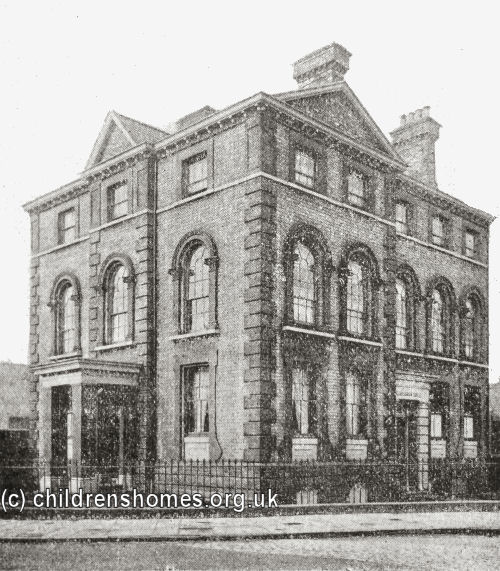Home for Friendless Girls / Clarendon House Home for Girls, Hull, East Riding of Yorkshire
In March 1886, the Hull Ladies' Association for the Care of Friendless Girls established a Home for Friendless Girls at 40 Clarendon Street, Spring Bank, Hull. The Home aimed to receive and train friendless girls, and to provide them with outfits and situations. In 1892, there were 11 beds and 4 girls in the house.
In 1892, the Home was taken over by the Waifs and Strays Society and became known as the Clarendon House Home for Girls. The existing matron, Miss L Beecham, continued in her post.

Clarendon House Home, Hull, c.1894. © Peter Higginbotham

Clarendon House Home, Hull, c.1894. © Peter Higginbotham
The ground floor of the Home included a dining-room, Matron's sitting-room, and a wardrobe-room where the girls' Sunday best clothes were kept. The first floor contained three dormitories for the girls, and a bedroom for a nurse and a baby. The Home's kitchen, scullery, larder, laundry and ironing-room were located in the basement.
The younger girls at the Home attended local schools while the older ones received training in domestic skills. On Saturdays, the younger children were taken out for a walk while the over-10s helped with domestic chores. A Bible class was held on Tuesday evenings, while Wednesday evenings were allocated for recreational pursuits such as playing games or singing. All the girls over eight years of age were deemed to be candidates for membership of the Girls' Friendly Society and a preparatory class was held every Thursday evening. Friday evenings were fill with the mending of clothes from the week's wash, and on Saturday evenings the matron taught the children the Collect for the following day, read through the Psalms with them, and found all the places in the Prayer Books for the Sunday services.

Clarendon House Home, Hull, July, 1911. © Peter Higginbotham
Growing demand for places at the Home led to the acquisition of some neighbouring houses which increased its capacity to 30 places. Eventually, however, it was decided to build a completely new Home. A site was found on Hessle High Road and July, 1914, construction work began on what became the Pickering Home for Girls which opened in September, 1915.
The Clarendon Street property no longer exists and a playing field now occupies the site.
Records
Note: many repositories impose a closure period of up to 100 years for records identifying individuals. Before travelling a long distance, always check that the records you want to consult will be available.
- Index of the Society's first 30,000 children's case files ordered by surname.
- Index of the Society's first 30,000 children's case files ordered by date of birth.
- The Children's Society Records and Archive Centre is at Unit 25, Springfield House, 5 Tyssen Street, London E8 2LZ (email: archives@childrenssociety.org.uk). Files for children admitted to its homes after September 1926 were microfilmed in the 1980s and the originals destroyed. Some post-1926 files had already been damaged or destroyed during a flood. The Society's Post-Adoption and Care Service provides access to records, information, advice, birth record counselling, tracing and intermediary service for people who were in care or adopted through the Society.
- The Society has produced detailed catalogues of its records relating to disabled children, and of records relating to the Children's Union (a fundraising body mostly supported from the contributions of children).
Bibliography
- Bowder, Bill Children First: a photo-history of England's children in need (1980, Mowbray)
- Church of England Waifs and Strays' Society [Rudolfe, Edward de Montjoie] The First Forty Years: a chronicle of the Church of England Waifs and Strays' Society 1881-1920 (1922, Church of England Waifs and Strays' Society / S.P.C.K.)
- Higginbotham, Peter Children's Homes: A History of Institutional Care for Britain's Young (2017, Pen & Sword)
- Morris, Lester The Violets Are Mine: Tales of an Unwanted Orphan (2011, Xlibris Corporation) — memoir of a boy growing up in several of the Society's homes (Princes Risborough, Ashdon, Hunstanton, Leicester) in the 1940s and 50s.
- Rudolf, Mildred de Montjoie Everybody's Children: the story of the Church of England Children's Society 1921-1948 (1950, OUP)
- Stroud, John Thirteen Penny Stamps: the story of the Church of England Children's Society (Waifs and Strays) from 1881 to the 1970s (1971, Hodder and Stoughton)
Links
- Hidden Lives Revealed — the story of the children who were in the care of The Children's Society in late Victorian and early 20th Century Britain.
- The Children's Society
Except where indicated, this page () © Peter Higginbotham. Contents may not be reproduced without permission.


